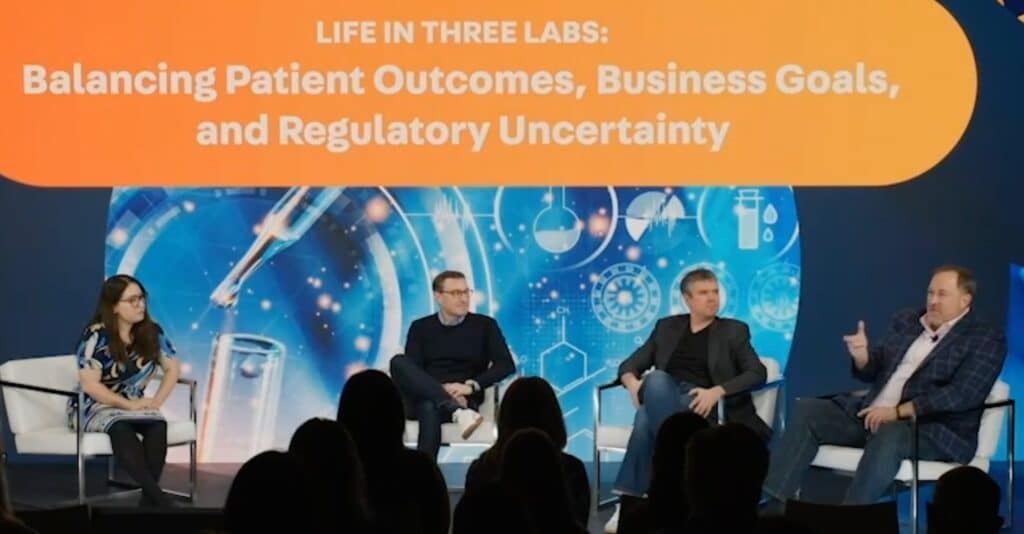At last week’s AdLab Health Marketing Summit, DeepIntent assembled leaders from across the pharma, marketing, and ad tech industries to address our current moment of transformation and the questions that define it.
The second panel of the day brought together Omnicom Health Group CEO Matt McNally and Natalie Mancuso, who has recently joined DeepIntent as SVP, Data Partnerships. Moderated by Carrie Craigmyle, DeepIntent SVP, Strategy, the conversation explored integrated HCP-DTC campaigns and how they will lead our industry forward.
In his introduction, DeepIntent CMO Adam Kapel explained that we usually look at HCP and DTC campaigns “under two microscopes. They’re treated differently. They’ve got different rules. But what if we looked at what happens when we put them under the same microscope? How do they interact? What changes?” McNally and Mancuso explored these questions and more—here are our top three takeaways.
1. Integrated campaigns help you understand patient and HCP audiences.
McNally shared that understanding your patient and HCP audiences in concert with each other enables newly powerful marketing and results. “From a media perspective, we’re trying to understand: what is the profile of the patient that is going into a certain doctor’s office, and what does that clinician look like? What are her hot buttons? Is she focused on efficacy? Is she focused on safety? Are the patients coming into her office? Do they even have access to the products that our brands are trying to understand and sell?”
To some extent, McNally said, gone are the years of “trying to generate awareness and generate questions and ‘ask your doctor about fill-in-the-blank.’”
McNally’s organization is working to match datasets such that they’re identifying the right consumers at play—and they are mapped to the right audience where they will learn about treatments that might be relevant to themselves, their friends, or family. Many highly educated patients are “going in with different questions and different concerns, and [their] physicians have different hot buttons.” So, looking at data from “an integrated patient-HCP perspective” when thinking about targeting, segmentation, and creative enables you to “deliver the best outcome at the point of care.”
“The more we can hub the data,” said Mancuso, “the more we can start to really add points of access for all of those folks in the ecosystem. We have a source of truth, we have a home base…and we know if I don’t bridge this one thing, I’m never gonna get down this value chain.”
Mancuso also emphasized the importance of bringing more self-service to customers, wherever they are in that value chain. They’re likely to want to be able to use low-code or no-code solutions. With that in mind, “how do we open up this ecosystem so that different platforms have interoperability, and data can be linked in ways that can be commonized on these open tokens?”
2. Integrated campaigns help you keep up with your customers.
Mancuso shared that she “always struggle[s] with why we have professional marketing and consumer marketing. They’re all consumers at the end of the day, right? We’re just talking about people playing a different role in the journey.”
Reiterating Mancuso’s view, McNally said, “We have to keep up with our customers, not the competition.”
To do so, Craigmyle noted that the pharma industry is increasingly looking to retail marketers for inspiration. McNally agreed, saying that pharma’s target customers “are engaging in retail and finance and luxury goods,” spaces where they benefit from highly specific personalization, or what DeepIntent CEO Chris Paquette termed “N-of-1 marketing” in his keynote. “That’s how a patient expects to be engaged. And I think we have a bigger responsibility in healthcare ’cause…we’re changing people’s lives. So, that outside-in lens is something that we’re really leaning into heavily.”
Mancuso conveyed her hope that more brands would feel empowered to take that transformative approach. Instead of the standard practice of having a budget set aside for innovation, “it’s what we should be doing in everything that we do.”
3. Integrated campaigns call for internal and external collaboration.
How do a brand and its agency partners influence HCP and patient consumers along their joint health journey?
According to McNally, pharma companies that have a mandate of integration are seeing positive results. “Organizations that have a CMO whose responsibility is to knit together a more integrated framework—it’s working. What I think agencies need to do a better job at is that cross-collaboration.”
Practically speaking, what might that cross-collaboration look like? McNally suggested that “even if you’re not from the same holding company” you can partner to do an integrated strategic brief that speaks to “content, creative, media, and HCP. You’ll look like heroes, right?”
Mancuso stressed that partnerships can help unearth unique data sources and bring disparate information together. “It’s a game changer,” she said. “Talk to your partners, bring your partners in, and trust your partners. We’re all in this together, and we should be working a lot more closely together and challenging each other. That’s the fun of it, right? Push on each other. Push on the industry.”
McNally echoed those sentiments, saying, “You gotta check fear at the door,” adding that his organization is “working on some products now that have not been done before because what is needed hasn’t been done before.” His mantra? “Be the case study.”
Mancuso added, “Test, learn, scale. Those are the three words that come out of my mouth constantly. Don’t always do things the traditional ways. Find ways that you can take advantage of the solutions that exist. Get your hands on things.”
DeepIntent believes in the promise of integrated campaigns to maximize the relationship between patients and providers and, in turn, maximize outcomes. Want to learn more about how integrated campaigns work and see a recent case study? Read it all here.


